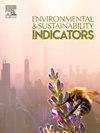To what extent cultivar selection can affect the environmental impact of rapeseed production?
IF 5.4
Q1 ENVIRONMENTAL SCIENCES
引用次数: 0
Abstract
Rapeseed (Brassica napus L.), ranked as the second most crucial oil crop globally, holds a prominent position in world agriculture, playing a pivotal role in meeting the increasing demand for edible oil and biodiesel. Pursuing sustainable goals in rapeseed production systems becomes paramount to addressing this growing demand. This study focuses on cultivar selection, a key factor for decision-makers striving to establish sustainable production systems. The investigation, conducted in Mazandaran province, Iran, the country's third-largest rapeseed producer, examines five commonly used cultivars: Zafar, Hyola, Traper, RGS003, and Neptune. Employing Life Cycle Assessment (LCA) with the IMPACT2002+ method, the study reveals varying environmental impacts among cultivars, contingent on the selected functional unit. Accordingly, based on one ton of harvested mass, RGS003 emerges as the most pollutant cultivar, while considering 1 ha of rapeseed farms, Traper exhibits the highest environmental impacts. nitrogen-based fertilizers stand out as major hotspots, contributing to over half of the negative effects across various categories. In conclusion, while factors like drought tolerance and disease resistance are crucial in cultivar selection, the environmental performance of cultivars also significantly influences the decision-making process.
求助全文
约1分钟内获得全文
求助全文
来源期刊

Environmental and Sustainability Indicators
Environmental Science-Environmental Science (miscellaneous)
CiteScore
7.80
自引率
2.30%
发文量
49
审稿时长
57 days
 求助内容:
求助内容: 应助结果提醒方式:
应助结果提醒方式:


